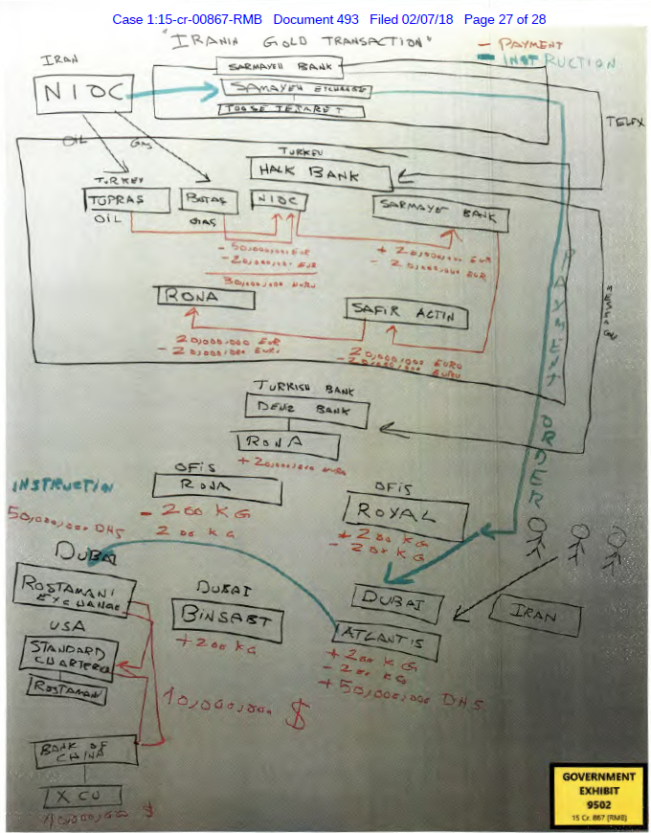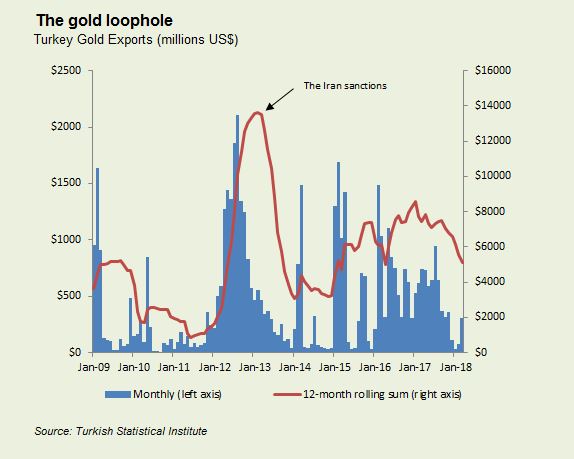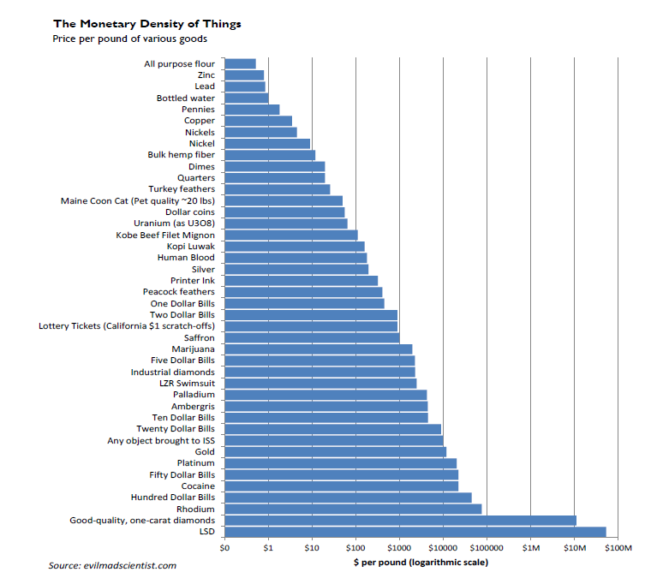Gold and the Monetary Blockade on Iran
This blog post is a guest post on BullionStar’s Blog by the renowned blogger JP Koning who will be writing about monetary economics, central banking and gold. BullionStar does not endorse or oppose the opinions presented but encourage a healthy debate.
With Donald Trump close to re-instituting economic sanctions on Iran, it’s worth remembering that gold served as a tool for skirting the the last round of Iranian sanctions. If a blockade were to be re-imposed on Iran, might this role be resuscitated?
The 2010-2015 Monetary Blockade
The set of sanctions that the U.S. began placing on Iran back in 2010 can be best thought of as a monetary blockade. It relied on deputizing U.S. banks to act as snitches. Any U.S. bank that was caught providing correspondent accounts to a foreign bank that itself helped Iran engage in sanctioned activities would be fined. To avoid being penalized, U.S. banks threatened their foreign bank customers to stop enabling Iranian payments or lose their accounts. And of course the foreign banks (mostly) complied. Being cut off from the U.S. payment system would have meant losing a big chunk of business, whereas losing Iranian businesses was small fry.
One of the sanctioned activities was helping Iran to sell oil. By proving that they had significantly reduced their Iranian oil imports, large importers like Japan, Korea, Turkey, India, and China managed to secure for their banks a temporary exemption from U.S. banking sanctions. So banks could keep facilitating oil-related payments for Iran without being cut off from the dollar-based payments system. The result was that Iran’s oil exports fell, but never ground to a halt. This was a fairly balanced approach. While the U.S. wanted to deprive Iran of oil revenue – which might be used to build nuclear weapons – it didn’t want to force allies to do entirely without necessary crude oil.
The U.S. Iran Threat Reduction & Syria Human Rights Act of 2012 (TRA) further tightened the noose. The TRA prevented Iran from repatriating any of the oil & gas funds that were accumulating in foreign escrow accounts maintained in Turkey, Japan, and elsewhere. To enforce this restriction, any bank proven to repatriate Iranian oil money would be cut off by its U.S. correspondent bank, thus losing its connection to the U.S. banking system.
The inability to unlock funds was inconvenient for Iran. There was no useful purpose to which the pariah nation could put all the Japanese yen, Indian rupees, Chinese yuan, or Turkish lira that was piling up in its overseas escrow accounts. Iran could still buy non-sanctioned goods and services in these countries and bring them back to Iran, say food, medicine, and whatnot. But none of the oil-importing nations provided Iran with enough importable stuff that it could draw its account balances down to zero. The funds held in escrow were dead money.
Gold Enters the Scene
This is where gold was recruited as a useful payments rail for evading the sanctions. The scheme was carried out primarily through Turkey. Gold dealer Reza Zarrab, one of the most well-known expediters of the scheme, designed an escape hatch for Iranian funds along with bank officials at Halkbank, a Turkish state-owned bank. Iranian funds frozen in a Halkbank escrow accounts (denominated in Turkish lira) were transferred to accounts held at Halkbank by Zarrab’s shell companies and used to buy gold in the Turkish gold market.
This technically was not illegal. While an earlier set of sanctions had prohibited banks from directly helping the Iranian government to deal in gold, it was still legal for them to help “private” persons to access gold, as long as the gold was sent to Iran and not elsewhere. Zarrab sent some of this gold directly to Iran. The rest was exported to Dubai where it was sold for dollars, the cash being returned to Turkey where Zarrab laundered it back into the banking system. Now the Iranian government could finally make use of it. Below is a chart that Zarrab made at his 2017 court trial that illustrates the complexity of the gold trade.

This size of this loophole was significant. According to Reuters, Turkish gold exports to Iran exploded from one tonne in 2011 to 125.8 tonnes in 2012, worth $6.5 billion. Another $4.6 billion was sent to Dubai, most of this ultimately destined for Iran. Below I’ve charted Turkish gold exports from 2008 to present. You can see the big bulge in 2012-13.
The large inflow of Turkish gold helped keep Iran afloat. It was only in mid-2013 that the “private person" loophole was finally cut off. Banks like Halkbank, which before could only be penalized for engaging in gold dealings with the Iranian government, were now prohibited from enabling gold payments for private Iranian entities as well. Gold shipments out of Turkey slowed to a trickle.

While Zarrab continued to illegally export small amounts of gold, he focused on a different form of sanctions busting: moving Iranian funds locked in Turkey to Dubai by using fake invoices for food and medicine as cover. But this too came to an end. During a visit to Disney World with his family in 2016, Zarrab was arrested and accused of helping Iran evade U.S. sanctions. In late 2017, he accepted a plea agreement and became the key witness against a number of Halkbank officials and Turkish government officials. Only one of them, Mehmet Atilla, has been convicted to date, the rest remain at large.
The Advantage of a High Value-to-Weight Ratio
In theory, the funds held in Iran’s escrow accounts at Halkbank could have been used to buy any sort of commodity, say copper, and then the copper shipped to Iran (or Dubai). The reason that gold was probably chosen as the in-between commodity is because it has a higher value-to-weight ratio than most commodities. Whereas an ounce of gold conveys $1300 in value, it would have required around 6,500 ounces of copper to convey $1300 in value. The extra bulk involved would have been very costly to ship.

Another advantage of gold relative to other commodities is that it is highly liquid. There are markets for the yellow metal all over the world that attract the participation of a wide range of buyers from consumers to industrial users to jewelers. Copper is much less marketable. Because Iran needed to on-sell whatever commodity was being used as the in-between commodity in order to get hard currency like euros and dollars, gold would have been the most convenient option.
A Monetary Blockade in 2018?
The monetary blockade that began in 2010 was eventually successful. Iran was forced to come to the negotiating table and in 2015 the Iran nuclear deal was signed. Zoom forward to today. Trump has left the nuclear deal and is threatening to reimpose sanctions against Iran. Could gold once again become a player in the game played between sanctioner and sanctioned?
One major difference between then and now is that there was significant global buy-in during the last round of sanctions. Prior to setting up the monetary blockade, the U.S. gained support from the United Nations Security Council, including China and Russia. So while certain loopholes were exploited, a broad consensus meant that evasion was not prevalent enough to bring the whole edifice down.
In exiting the Iran deal last month, Trump has done so alone. Presumably this lack of consensus will make any ensuing round of sanctions much more leaky than the initial ones. India, for instance, has already said that it won’t comply with the sanctions because they are not UN-mandated. Now, in actuality there probably isn’t much India can do to escape the sanctions. The majority of Indian banks will comply because they will be wary about the threat of being cutoff from the dollar-based payments system.
But with a wink and a nod from their national governments, a few banks who don’t do much U.S. business may decide to take Iran on as a customer. They will need some sort of popular medium for expediting payments to and from Iran, say gold, euros, bitcoin, or an up-and-coming national currency such as the Chinese yuan. It remains to be seen which one would be selected, but gold certainly has a number of useful properties, as evidenced by the last round of sanctions. Whatever the case, the U.S. dollar’s dominant role as a global medium of exchange can only be weakened by another round of Iran sanctions.
Sources used to write this post:
- Iran’s Turkish connection, Reuters, 2014 (pdf)
- Aggressive U.S. Monetary Policy… in Iran, 2012 (Moneyness blog)
- United States of America vs Reza Zarrab et al, 2017 (pdf)
- United States of America vs Mehmet Hakan Attila, 2018 (pdf)
- Iran’s Gold Loophole, 2013 (pdf)
- Sanctions Against Iran: A Guide to Targets, Terms, and Timetables, 2015 (pdf)
- The Beauty of TRA Section 504, 2015 (Sanctions Law blog)
- OFAC FAQs: Iran Sanctions (US Treasury website)
- Exiting the Iran deal is a blow to financial transparency and US control, 2018 (Interfluidity blog)
Popular Blog Posts by JP Koning
 How Mints Will Be Affected by Surging Bullion Coin Demand
How Mints Will Be Affected by Surging Bullion Coin Demand
 Banknotes and Coronavirus
Banknotes and Coronavirus
 Gold Confiscation – Can It Happen Again?
Gold Confiscation – Can It Happen Again?
 Eight Centuries of Interest Rates
Eight Centuries of Interest Rates
 The Shrinking Window For Anonymous Exchange
The Shrinking Window For Anonymous Exchange
 A New Era of Digital Gold Payment Systems?
A New Era of Digital Gold Payment Systems?
 Life Under a Gold Standard
Life Under a Gold Standard
 Why Are Gold & Bonds Rising Together?
Why Are Gold & Bonds Rising Together?
 Does Anyone Use the IMF’s SDR?
Does Anyone Use the IMF’s SDR?
 HyperBitcoinization
HyperBitcoinization






 JP Koning
JP Koning 2 Comments
2 Comments










